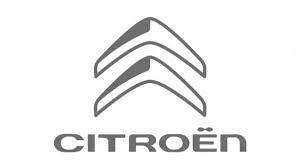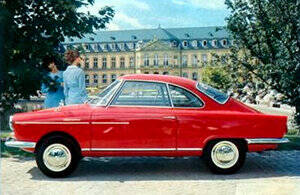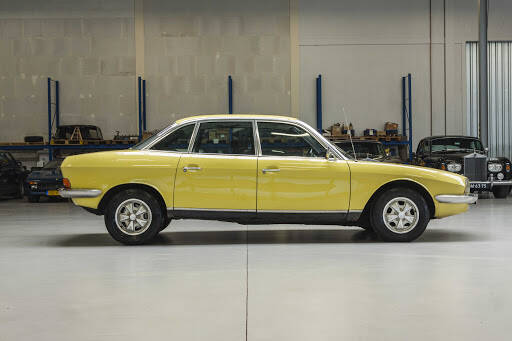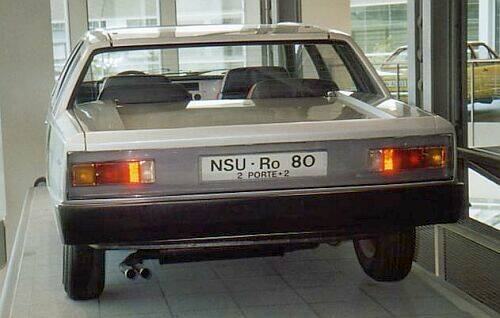





NSU originated as the "Mechanische Werkstätte zur Herstellung von Strickmaschinen", a knitting machine manufacturer established in 1873 by Christian Schmidt, a technically astute entrepreneur, in the town of Riedlingen on the Danube. The business relocated in 1880 to Neckarsulm. There followed a period of rapid growth and in 1886, the company began to produce bicycles, the first of them a 'high wheeler' or 'Penny-farthing' branded as the "Germania". By 1892, bicycle manufacturing had completely replaced knitting machine production. At about this time, the name NSU appeared as a brand name.
The first NSU motorcycle appeared in 1901, followed by the first NSU car in 1905.

1953

1953

1957

1955

In 1932, under pressure from their bank (Dresdner Bank), NSU recognised the failure of their attempt to break into volume automobile production, and their recently built car factory in Heilbronn was sold to Fiat, who used the plant to assemble Fiat models for the German market. From 1957, NSU-Fiat cars assumed the brand name Neckar.
During World War II NSU produced the Kettenkrad, the NSU HK101, a half-tracked motorcycle with the engine of the Opel Olympia. They also made the 251 OSL motorcycle during the war.
In December 1946, Das Auto reported the company had resumed the manufacture of bicycles and motor-bicycles at Neckarsulm. For Germany, this was a time of new beginnings, and in July 1946, a new board was appointed, headed by General Director Walter Egon Niegtsch, who earlier in his career had spent 17 years with Opel.
NSU motorbike production restarted, in a completely destroyed plant, with prewar designs like the Quick, OSL, and Konsul motorbikes; furthermore, the HK101 continued to be sold by NSU as an all-terrain vehicle in a civilian version. The first postwar model was the NSU Fox in 1949.
In 1957, NSU re-entered the car market with the new Prinz (Prince), a small car with a doubled NSU Max engine, an air-cooled two-cylinder engine of 600 cc and 20 hp. Motorbike production continued until 1968. NSU's last production motorcycle was the Quick 50.
prinz

1958-1962


1959

1960
The first post-war NSU car, the Prinz I, was launched at the Frankfurt Motor Show in September 1957 accompanied by the advertising slogan "Fahre Prinz und Du bist König" ("Drive a Prince and you're a king"). After a pilot run of 150 preproduction cars, volume production began in March 1958.
The Prinz I was available as a 2-door saloon featuring an upright roof line and seating for four people. The doors opened wide enough to permit reasonable access even to the rear seats, although leg room was severely restricted if attempting to accommodate four full sized adults.[2] In addition to a luggage compartment accessed via a hatch at the front of the car and shared with the spare wheel and fuel filler, there was a narrow but deep full width space behind the rear seat sufficient to accommodate a holiday suitcase.[2]
The noisy two-cylinder 600 cc 20 PS engine was located at the back where it drove the rear wheels, initially via a "crash" gearbox. Later versions gained a four-speed.
The Prinz II (a 'luxury' version) was released in 1959 with better trim and an all-synchromesh gearbox. A 30E export version was equipped with a 30 hp engine.
The Prinz III was launched in October 1960 featuring a new stabilizer bar and the 30 hp motor. NSU received government approval to build the Prinz in Brazil in the late 1950s, but nothing came of the project.

In 1964, NSU offered the world's first Wankel engined car: the Wankelspider. In development of the project, NSU built the Sport Prinz, with a 129 hp 995 cc 2-rotor. The Typ 110 (later called 1200SC) was launched in 1965 as a family car with a more spacious body design. The last NSU cars with a conventional four-stroke engine had the air-cooled OHC four-cylinder engine in common. Also in 1964, NSU partnered with Citroën to develop the Wankel engine via the Comotor subsidiary, which resulted in the abortive 1973 Citroën GS Birotor production car.
A two rotor GS was launched in 1973. Dubbed the Citroën GS Birotor (also called Citroën GZ), it featured a much more powerful 106 hp Wankel birotor produced by the joint NSU-Citroën Comotor project. This style of motor is noted for its smooth power delivery which complemented the luxurious ride quality of the hydropneumatic suspension. Even better, the engine was small relative to its power, an advantage for Tax horsepower calculations, which drive automobile design in France.

The Birotor cost as much as the larger Citroën DS, and 70% more than the standard GS. The fuel economy was worse than the largest DS - the DS23EFI. Since it was not economical for its size, and was launched in October 1973, the exact start of the 1973 oil crisis, the Birotor version achieved poor sales and was quickly pulled from the market, after 847 units were sold.
sport prinz

1958-1968



The Sport Prinz was a 2-seater sports coupe variant. It was designed by Franco Scaglione at Bertone studios in Turin. 20,831 were manufactured between 1958 and 1968. The first 250 bodies were built by Bertone in Turin. The rest were built in Heilbronn at Karrosseriewerke Drauz which was later bought by NSU.
The Sport Prinz was initially powered by the 583 cc Prinz 50 straight-twin engine but a maximum speed of 160 km/h was nevertheless claimed. From late 1962 a 598 cc engine was fitted.
The NSU Spider was a Wankel rotary powered two-seater roadster based on the Sport Prinz platform.

One of the revelations of the Frankfurt Motor Show in September 1961, the Prinz 4 replaced the original Prinz. Its new body closely resembled the then fashionable Chevrolet Corvair, but was of course much smaller. Like the original Prinz, it was powered by a two-cylinder air-cooled engine in the rear. The Prinz 4 was much improved and continued to be a well-engineered car, like its predecessors. The engine carried on the tradition of eccentric rod driven camshaft inherited from NSU motorcycle engines and had a dynastart (combined starter/generator) built into the crankcase. Later four-cylinder engines adopted the more conventional (pre-engaged) separate starter motor and alternator. The test car achieved a top speed of 113 km/h and accelerated to 97 km/h in 35.7 seconds

The NSU Prinz evolved into the somewhat larger bodied NSU Prinz 1000, introduced in1963. A sporting NSU 1000 TT (with a 1.1 litre engine) also appeared, which was later developed into the NSU (1200) TT and NSU TTS models. All had the same body with inline-four air-cooled OHC engines and were frequently driven as sports cars, but also as economical family cars as well. The engines were very lively, and highly reliable. Paired with the low total weight, excellent handling and cornering, both the NSU 1000 and the much higher powered NSU 1200 TT/TTS outperformed many sportscars. The Prinz 1000 lost the "Prinz" part of the name in January 1967, becoming simply the NSU 1000 or 1000 C depending on the equipment. It has 40 PS, while the 1200 TT has 65 PS and the most potent TTS version has 70 PS from only one litre.

The NSU Typ 110 was a small car first presented in 1965, widening NSU’s range in the process. It was based on the NSU Prinz 1000 but with a longer wheelbase and a front overhang which increased available space both in the passenger cabin and in the luggage compartment. With an external length of four metres the car took NSU into the lower rungs of the middle class saloon sector, as it existed at that time in West Germany. It was to distance the model from the small car sector that for this model NSU abandoned the Prinz name which had till then been carried by their passenger cars. The Typ 110 and the Prinz 1000 were powered by rear-mounted air-cooled four-cylinder engines. The Typ 110 came with a 1085 cc engine with a claimed output of 49 PS, which would also find its way into the sporting smaller Prinz 1000 TT, albeit with a slightly higher claimed output of 54 PS. In the autumn of 1966 a larger engine of 1177 cc 60 PS became available in a version designated as the NSU Typ 110 S or 110 SC.

Later in 1967 NSU simplified their model range. The NSU Typ 110 was rebranded as the NSU 1200, with claimed engine output now reduced back to 54 hp. In this form it continued to be offered in Germany until December 1972. A "C" ('comfort') version had a 'generous range of special equipment'.
The top speed achieved had increased from 140 km/h to 150 km/h. The acceleration time from 0 to 80 km/h had come down from 12.3 seconds to precisely 10.0 seconds. There was also a 10% improvement in overall fuel consumption.
spider

1964-1967



First appearing at the Frankfurt Motor Show in 1964, the Spider featured a two-door cabriolet body based on that of the NSU Sport Prinz coupé introduced back in 1959. In addition to the folding roof, the Spider was distinguishable from the hard top car by a grill at the front. As with all NSU cars at the time, the engine was rear-mounted: in order to improve weight distribution, space was found for the Spider’s radiator and for its 35-litre fuel tank ahead of the driver. The front luggage locker was in consequence small. There was a second luggage area in the rear of the car above the engine. It appears that NSU Spiders were painted either red or white.
Invented by Felix Wankel, the Wankel engine differed from a piston engine because the quasi-oval design of the combustion chamber. The result was a remarkably compact free-revving engine which, in the 1960s, was hailed by some as the next major step forward in automobile design. It was later found that the characteristics of critical materials selected and applied by NSU to build production rotary engines were inappropriate to the stresses they would bear, and rotary-engined cars earned a reputation for unreliability.
Claimed output was initially 50 bhp at 5,500 rpm, though in later models 54 bhp at 6,000 rpm was advertised.
Between 1964 and 1967 2,375 were built. In 1967, the model was withdrawn and NSU's second rotary-engined production saloon was presented.
ro80


1967-1977



The NSU Ro 80 is a four-door, front-engine executive sedan manufactured from 1967 until 1977.
Noted for innovative, aerodynamic styling by Claus Luthe and a technologically advanced powertrain, the Ro 80 featured a 113 bhp, 995 cc twin-rotor Wankel engine driving the front wheels through a semi-automatic transmission with an innovative vacuum-operated clutch system. Other technological features of the Ro 80, aside from the powertrain, were the four-wheel ATE Dunlop disc brakes, which were generally only featured on expensive sports or luxury saloon cars. The styling, by Claus Luthe who was head of design at NSU and later BMW, was considered very modern at the time; the Ro 80 has been part of many gallery exhibits of modern industrial design. The large glass area foreshadowed the 1970s designs such as Citroën's. The shape was also slippery, with a drag coefficient of 0.355 (very low for the era). This allowed for a top speed of 180 km/h. Indeed, comparisons have been drawn between the design of the Ro 80 and the aerodynamic 1982 Audi 100 built in the same factory some 15 years later.
The car developed an early reputation for unreliability. The Ro 80 engine in particular suffered from construction faults, among many other problems, and some early cars required a rebuilt engine before 50,000 kilometres, with problems arising as early as 24,000 kilometres.
The Ro 80 remained largely unchanged over its ten-year production. The Ro 80 was voted Car of the Year for 1968 and 37,398 units were manufactured over a ten-year production run, all in a single generation.
After the discontinuation of the Ro 80 in 1977, the Neckarsulm plant was switched over entirely to producing Audi's C- and D- platform vehicles (the 100/200, and later the Audi A6 and A8), and the NSU brand disappeared from the public eye.

The development of the rotary engine was very cost-intensive for the small company. Problems with the apex seals of the engine rotor significantly damaged the brand's reputation amongst consumers. In 1969, the company was taken over by Volkswagenwerk AG, which merged NSU with Auto Union, the owners of the Audi brand which Volkswagen had acquired five years earlier. The new company was called Audi NSU Auto Union AG and represented the effective end of the NSU marque with all future production to bear the Audi badge (although retaining the four interlocking circles of Auto Union). The management of the new combine was initially based at the Neckarsulm plant, however when the small rear-engined NSU models (Prinz 4, 1000, 1200) were phased out in 1973, the Ro 80 was the last car still in production carrying the NSU badge. Audi never made use of the brand name NSU again after April 1977, when the last Ro 80 was sold. In 1985, the company name was shortened to Audi AG and management moved back to Audi's headquarters in Ingolstadt.

Even as production of the Ro 80 continued in the Neckarsulm plant, production of larger Audi models like 100 and 200 was started. The Porsche 924 and later Porsche 944 were also assembled at Neckarsulm. Those models were joint venture projects of Porsche and VW, but Porsche did not have the internal capacity to build the 924 and 944. Currently, Neckarsulm is the production plant for Audi's topline vehicles like A6, A8, and R8. It is also the home of the "Aluminium- und Leichtbauzentrum" where Audi's aluminium-made space frame bodies are designed and engineered.
k70

1970-1975



The Volkswagen K70 is a four-door, front engine, front wheel drive sedan developed by NSU and marketed from 1970–1975 by Volkswagen after its 1969 acquisition of NSU.
Designed by NSU's chief engineer Ewald Praxl and styled by Claus Luthe as a four-door sedan (and three-door wagon) to complement the NSU Ro80, the K70 would become the first Volkswagen with a front-mounted engine, water cooling and front wheel drive. Competing with VW's own 411/412 and Audi's 100, the K70 was ultimately sold only as a sedan, with 211,127 examples manufactured for model years 1970–1975.
The K70 retained NSU's naming convention, as introduced with the Ro 80 — with K denoting the German word Kolben (piston) and 70 designating an engine output of 70 PS.
In total, 23 pre-series K70s with NSU badging were built.
The K70 was replaced in 1973 by the Audi-based Volkswagen Passat, although it continued in production until February 1975, by which time Volkswagen had produced 210,082 K70s. An alternative source gives the production total for the K70 as 211,127.
pininfarina ro80





Based on the NSU Ro80 (powered by a rotary-engine), Pininfarina presented this unique concept-car. Back in 1971 it featured safety features, like shock-absorbing bumpers,
and extra strengthened doors, to prevent injuries, caused by side-impacts. Elastic bumpers, without chrome gives the car a modern look, even 30 years after the car was presented at Motor Show of Torino, Italy. The dark colored part of the body is the reflected image of the roofline. The roof can be folded down, on the trunk-lid.
The car is now part of the Audi Collection.
ep4

2023


Audi apprentices put an electric spin on an iconic classic car. The team “awoke” an NSU Prinz 4 from 1971 from its sleep, charging it up with technology from the Audi e-tron EV.
In honor of the 150th anniversary of its Neckarsulm site, Audi put its apprentices to the task of restoring a classic car with an all-electric drive train.
The team revealed the NSU Prinz 4 EV, now called the Audi “EP4”. The “E” stands for electric drive, while the P4 is in honor of the NSU Prinz 4, a classic car produced in Neckarsulm by NSU Motorenwerke from 1961 to 1963.
Fitted with a 240 hp electric motor from a 2020 Audi e-tron at the rear, the EV is eight times more powerful than the NSU Prinz 4’s original two-cylinder gas engine that had 30 hp.
In addition, the team placed a battery from the Audi Q7 TFSI e-quattro plug-in hybrid under the front hood, once home to the fuel tank. The EV “breathes” through an open-air intake at the bottom bumper, while heat can escape through the opening in the hood.
The electric classic car’s tailgate can be fixed into a half-open position to highlight the “electric power plan,” reminiscent of the iconic racing cars based on the NSU Prinz 1000.
The NSU Prinz 4 EV conversion took significant modifications to the chassis and body. Its modified floor plan includes an Audi A1 as a base, including the brakes and axles. Adding muscular fenders from a 3D printer, the team mounted the modified (and significantly widened) body on top.








Create Your Own Website With JouwWeb